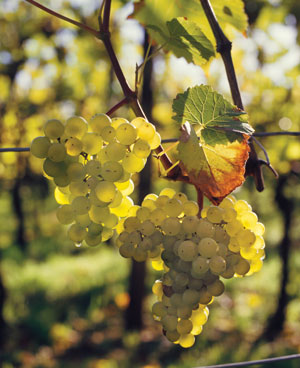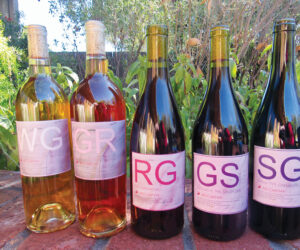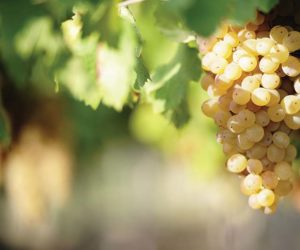 The Seyval Blanc (Seyve-Villard 5276), a cold-climate white grape variety, is the leading choice for many winemakers who live in the chilly eastern and northern regions of North America. This hardy varietal produces abundant crops in cold climates and offers the winemaker an opportunity to make a variety of wines from one grape.
The Seyval Blanc (Seyve-Villard 5276), a cold-climate white grape variety, is the leading choice for many winemakers who live in the chilly eastern and northern regions of North America. This hardy varietal produces abundant crops in cold climates and offers the winemaker an opportunity to make a variety of wines from one grape.
Seyval Blanc can be made in a fruity, crisp style for early drinking, or in a more austere style, like many Chardonnays. The variety also lends itself well to making dessert wines and sparkling wines. And, perhaps the best asset of all, Seyval Blanc is an outstanding blending wine that enhances whatever variety with which it is matched. Whether you buy Seyval Blanc grapes or juice, the prices are usually much lower than for other premier varieties.
Seyval Blanc was born in the latter part of the 1800s as a result of the disastrous phylloxera plight, which ravaged the vineyards of Europe and most of the world. The native American varieties (vitis labrusca) were immune to phylloxera, but the European cultivars (vitis vinifera) were not.
Scientists at European and American universities and government agencies began crossing and grafting vines from both sides of the Atlantic. They developed new and stronger grape strains, allowing vineyards to grow noble grape varieties in Europe and America again. Seyval Blanc was one of the many hybrids that emerged from these technological advances. The noble European varieties were grafted onto the American vine’s rootstock, resulting in a disease-resistant vine.
American wine pioneer Philip Wagner established the Boordy Vineyards in Riderwood, Maryland in the 1940s and helped to revive the wine industry in east and northern North America by developing a nursery specializing in Seyval Blanc and other hybrid grape types.
Back then, like today, the exact location of the vine (the terroir) was of paramount importance. Advances in technology and modern research have assisted present-day grape growers in producing prolific amounts of quality Seyval Blanc.
Today, Seyval Blanc is grown in most eastern U.S. states and areas of Canada. It is estimated that Seyval Blanc is grown in varying quantities in 40 U.S. states.
The Seyval Blanc prefers cooler climates, reasonable moisture and warm days during the growing cycle. Seyval can and does withstand harsh, cold winters and short growing seasons, making it an ideal variety for northern and eastern U.S. regions and Canada.
In most of the Seyval growing regions, the variety matures to the 18° to 20° Brix range and 0.8 to 1.5 percent acid counts. In most cases, sugar and acid adjustments must be made in order to balance the wine for a successful conclusion. The recommended ranges of sugar and acid counts are 20° to 22° Brix and 0.6 to 0.9 percent acid. Growers throughout the U.S. who have harvested Seyval Blanc have reported Brix counts from 15° to 23° and acid counts from 0.6 to 1.5 percent. The cooler climates have lower Brix counts and higher acids and the warmer climates have the opposite.
The hardy Seyval Blanc offers the winemaker many options. I have been making Seyval Blanc wine for more than 25 years and I love the variety’s easy versatility. It clarifies easily, maintains excellent fruit, has nice complexity and body and is an excellent blending wine. I blend Seyval Blanc with all of my California white varieties to punch up their lower acids and help to lower their sugar counts. I buy Seyval Blanc juice, which saves me two steps (crushing and pressing) in the process. Seyval is available as fresh grapes or juice.
I add one gallon of Seyval to four gallons of California juice before fermentation. I like the balance and the complexity of the final results. I’ve used a variety of different yeast strains over the years and continue to experiment each year.
When using fresh grapes, eliminate the rotten and green grapes before crushing and adjust sugar and acid before the fermentation is started. After you press out the grapes, put the juice in glass 5-gallon carboys and add 1/2 teaspoon of potassium metabisulfite powder to each carboy, or 5 Campden tablets crushed to a powder. Fill each carboy to the brim, cover it and let it sit overnight. The next day, rack the clear juice into clean 5-gallon carboys (there will be mostly clear juice with sediment at the bottom) and leave the sediment behind. Test the juice and make your adjustments to the 20° to 22° Brix range and to the 0.6 to 0.9 percent acid range. Then inoculate with your yeast choice, leaving room at the top of the container for fermentation overflow. If you have a cool site available, use it.
For those who make sparkling wines, Seyval Blanc is an ideal choice. The Hopkins Vineyard in New Preston, Connecticut, uses Seyval Blanc as the primary variety for their sparkling wine made in the French Champagne style. They also make a Seyval varietal wine in the fresh, fruity, non-malolactic style using the Lalvin 71B-1122 yeast strain.
The Seyval Blanc vine can overproduce, which can mean diluted grape flavors when picked. Leaf and grape pruning, during the maturing season, is necessary and final production amounts in the three to five tons-per-acre category seem to be ideal. Here’s a simple method for making a fruity style Seyval Blanc wine from Seyval Blanc juice.
Seyval Blanc Recipe
(5 gallons; 19 liters)
Ingredients:
5 gallons (19L) Seyval Blanc juice
1 package (5g) Red Star Cotes des Blanc yeast
3 tsp. (8.8g) yeast nutrient
20 Campden tablets or 2 tsp. (12.4g) potassium metabisulfite powder
Step by Step:
1. Sanitize all equipment.
2. Through a screened funnel, pour 4 gallons (15 L) of juice into a 5-
gallon (19 L) glass carboy and the remaining gallon (3.8 L) of juice into two 1-gallon (3.8 L) jugs.
3. Test for sugar and acid and make adjustments, if necessary. When SG is 1.070 to 1.090 (20° to 22° Brix), make a yeast starter by pouring 4 ounces (120 mL) of juice into a bowl. Sprinkle the yeast and yeast nutrient into the solution, allowing it to proliferate for about 30 minutes. Add 6 oz. (180 ml) of the yeast starter to the carboy and 1 oz. (30 ml) of the starter to each of the 1-gallon (3.8 L) containers. Swish the containers to aid in the blending.
4. Place a sheet of paper towel, a wad of cotton, or a paper napkin into the necks of the containers. Fermentation will start in 2 or 3 days. When the must is actively “bubbling,” replace the paper with airlocks, filled with clean water, for the rest of the fermentation.
5. Fermentation will continue for 7 to 12 days. Monitor the progress with the hydrometer after 7 days. When the SG is below 1.000, proceed to the next step. If it’s above 1.000, allow the wine to ferment longer, until it reaches a SG of 1.000 or less.
6. Once the SG is below 1.000, and has maintained that reading for at least two weeks, siphon the clean wine from the three containers into a sanitized carboy. Stabilize the wine by adding 5 Campden tablets (crushed to a powder) or 1/2 teaspoon (3.1 g) potassium metabisulfite powder. Then fill the container to the top. Place in a cool spot (such as a garage or root cellar).
7. Let the wine sit in this cool location for 3 to 4 weeks to cold stabilize. If you let it stay longer, rack again every 3 to 4 weeks. At each racking, add 3 crushed Campden tablets or 1/4 teaspoon (1.6 g) potassium metabisulfite powder. After the fourth racking, the wine should be clear enough to bottle.
8. If the wine doesn’t clear, use gelatin or kieselsol, fining agents. (Follow directions for procedures and quantities.) When fining, the wine will need an additional 3 to 4 weeks to clear. If a fining agent has to be used, then filtering is advised before bottling.
9. Bottle when the wine is clear. Taste and adjust its sweetness, then bottle. If the final wine is to be sweetened, then add potassium sorbate at a rate of 2-1/2 tsp. (7.5 g) per 5-gallon (19 L) carboy. Also add 3 Campden tablets crushed to powder or 1/4 tsp. (1.4 g.) of potassium metabisulfite powder to the 5-gallon carboy to ensure that the wine won’t ferment after bottling. Age for at least 6 months before tasting.






